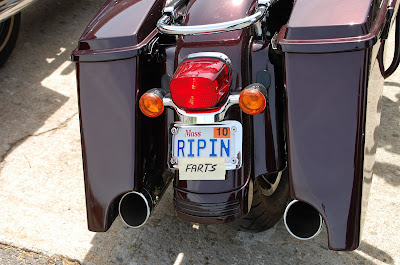It turns out that bumping into a rival motorcycle club member clutching a bloodied crescent wrench inside a Laughlin casino isn't necessarily the most treacherous part of the annual Laughlin River Run.
If you're a motorcyclist, it's actually the trip to the riverside town that can prove deadly.
Admittedly, I am uneducated when it comes to motorcycles and safety.
I'm what my Bay Area biking friend Marty calls a "cager," which at first seemed a bit offensive until I learned it simply means my transportation of choice is a car.
Over the next few days, an estimated 100,000 bikers are expected to roll through the Las Vegas Valley on their way to the River Run festivities.
What this means, according to Allstate Insurance anyway, is that we cagers need to be aware of those on two wheels.
Now before we proceed, allow me to share with fellow cagers a question posed to Marty when he explained that motorists are careless when it comes to motorcycles.
Essentially, Marty was asked about the uncaring behavior of the biker jackasses who swerve in and out of traffic on the freeway when everyone is moving at a steady 70 mph. Jackass is not the proper term, he said; those guilty of this irritating practice are "squids."
Squids are typically in their early 20s and they don't bother to undergo formal training before hopping on a sport bike (known as crotch-rockets in the world of motorcycle enthusiasts) and tearing down the freeway.
The other class of less responsible bikers are, in Marty's words, "baby boomer yuppies" who hit a midlife crisis and purchase a Harley-Davidson far too big and powerful for their skill level. They might take their ride down to the neighborhood bar and show it off, then overconsume and wipe out.
The sluggish economy coupled with soaring fuel prices prompted the population of these two classes of bikers to explode over the past couple years. Aside from yuppies and squids -- and by the way, motorcyclists are bitter that they tarnish the community's reputation -- most bikers take pride in respecting others on the road and take safety seriously.
(As my friend Dean said after witnessing a bare-footed weed-whacking session, safety doesn't have a quitting time).
According to the online Hurt Report, three-fourths of motorcycle accidents involve a passenger vehicle. And in the majority of those accidents, the vehicle violated the motorcyclist's right-of-way; drivers didn't see the biker until it was too late.
Intersections are the most common location for motorcycle-vehicle crashes. In 2008, 75 percent of the 961 motorcycle-involved accidents in Clark County were at intersections or in close proximity to major crossings, according to Allstate's figures.
This is where Dave Perewitz, a Massachusetts-based chopper builder, comes in.
Perewitz is an ambassador of the new program dubbed ONE: Once is Never Enough. The campaign encourages motorists and motorcyclists alike to look left, right and left again when at an intersection. You remember the drill; we all learned it in kindergarten.
"People are so excited about getting to the event and looking at the cool bikes, they're not paying enough attention to what they're doing or where they're going," Perewitz said. "Take that extra few seconds at an intersection to look twice, because once isn't enough. That could prevent a crash. It could save someone's life. It could save your life."
Perewitz is teaming up with Allstate to place yellow signs reminding motorists to be aware of motorcyclists. You might see the signs at two intersections deemed to be the most frequent site of motorcycle collisions: Tropicana Avenue and Koval Lane and Rancho Drive and Washington Avenue.
Perewitz believes the elevated awareness will prevent accidents.
































